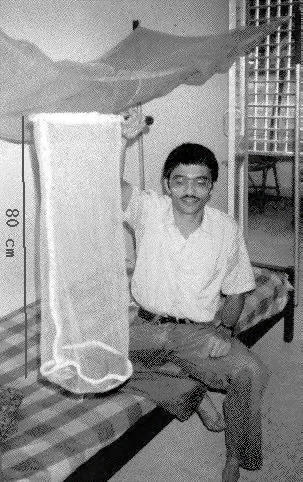Warning:
Catching of poisonous snakes is a very dangerous hobby. Although the technique described is almost completely safe, the keyword here is almost. Be afraid, be very afraid. The problem in snake catching is not so much of skill, as one of attitude and confidence. Do not try this unless you are very clearly aware of what you are doing.
The technique described here should work with any Indian snake except very large ones like pythons and king cobras. Full grown ratsnakes will also give some trouble. Happy snake catching!

Equipment:
Get yourself an old but unbroken badminton racquet. An old tennis racquet will also do. Remove any gutting that may be present. Buy a large piece of nylon mosquito netting (inquire at the local mosquito net shop, as to where they get their nets from). These nets are available by the meter. One square metre is adequate for one snake catching net. Here in Pune, India such a net made of nylon, costs Rs. 20 ($ 0.50).
The dimensions for the net, are as shown in the photograph. The length can be made a little longer than shown, say 100 cm, to make it easier to catch large snakes like ratsnakes, which are very powerful, and can climb out of the smaller net shown here. The net should be hand stitched properly to the racquet through the holes meant for the gutting. The nylon thread used in racquet gutting is strong and durable and is available in sports stores. The bottom circular portion of the net can be stitched to the net using a cloth ribbon to interconnect them. You may use a double layer of mosquito netting at the bottom for additional safety. Make sure that all stitches are secure by carefully tugging at all vulnerable points.
Catching Procedure:
When a snake is spotted, it is imperative that you reach the scene, as fast as possible, along with the net. Always keep the net in a place of easy access. If the snake is in an open area, catching it will be much easier. In such a case, hold the net in front of the snake's head and move it as the snake moves, keeping the opening of the net, near the head of the snake. The aim is to trick the snake into thinking, that the net is a convenient place to hide. The moment it realizes that, it rushes into the net and all you have to do is to raise the net quickly, so that it does not rush out again.
At no stage should you attempt to touch the snake, grab it by the tail or agitate it any other manner. Such antics serve no purpose and are also extremely dangerous.
Once a snake is taken you can tie the top of the net tightly with a leather belt. If the snake has been identified to be harmless, it may be taken out of the net and placed in a large cloth bag, with a strong string at the mouth of the bag so that it can be closed. If the snake is poisonous, the whole net along with the belt, can be put into a large cloth bag whose mouth is tied tightly with a strong thin string. After you gain some experience with handling snakes, you can even transfer poisonous snakes out of the net and into a cloth bag.
If the snake is trapped in a closed room catching it can be quite difficult and dangerous. Try to ascertain if the snake belongs to a poisonous species. If it is poisonous, it is a good idea to try to try to drive the snake out of the room into an open area before trying to catch it.
Identification:
The next crucial step is correct identification. Remember this maxim: Every snake is poisonous unless it has been proved to be otherwise.
The only accurate, detailed and complete guide to Indian herpetofauna presently available is The Fauna of British India, Ceylon and Burma, including the whole of the Indo Chinese sub-region. Reptilia and Amphibia Vol. 3 by M.A Smith reprinted by Natraj Publishers, Dehra Dun, Cost: Rs. 250. This book has scale counts and keys using which it is possible in principle, to identify any snake. You may need help from a local expert to learn how to use this book. It is difficult reading for anyone but a professional herpetologist.
There are other books available, some of them with good photographs. In my opinion, these guides are not useful for unambiguous identification, because they lack scale counts and keys. You should stick to the book by Smith, until something better is published.
Care and Release:
Almost all snakes (except very young individuals) can survive a couple of days without food and water. If the weather is hot, the snake can be dropped into a bucket with a few inches of water. Place a stone or similar object for the snake to rest on when inside the bucket. I have observed Trinkets actually drinking the water in the bucket, when placed in this way.
Snakes are more than happy to spend a couple of days, in the cloth bag you will place them in. Non-poisonous snakes can be released near habitated places, but choose a time when there will not be too many people about, if you want to avoid confrontation. Poisonous snakes should be handed over to a government run snake park, if one is present nearby, or released into the wild.